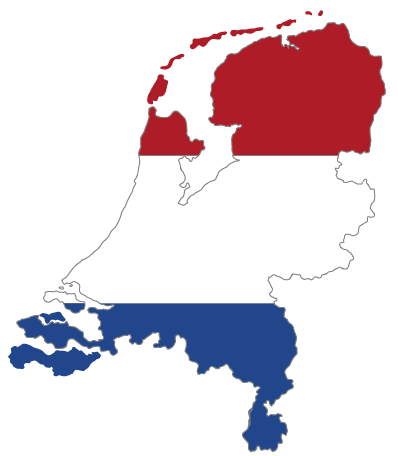Language History
Old Dutch in the medieval period became the main language spoken in areas that would later become the southern Netherlands and northern Belgium. This was mainly a spoken language, however there are several existing documents that exist like the Hebban olla vogala poem. Later, Old Dutch developed into Middle Dutch which split into several regional dialects. It was in the 14th century when attempts were made to standardise the Dutch language.
In 1637, the Protestant leaders of the Dutch Republic published a new Dutch version of the Bible which had great influence from Hebrew and German Bible texts. This led to the standardisation of the Dutch language and how it is now known today (although there have been changes over the centuries). In the colonial period, Dutch developed into several Creoles languages and split into Afrikaans –mainly spoken in South Africa and Nambia.
[/vc_pangea_service_desc_block][/vc_column][/vc_row][vc_row css=”.vc_custom_1621797516802{background-color: #f1f2f0 !important;}” el_class=”bg-grey”][vc_column css=”.vc_custom_1558445967850{margin-top: -90px !important;margin-bottom: -70px !important;}”][vc_pangea_custom_block layout=”center” button_color=”#d15f45″ content_font=”Open Sans” button_popup_form=”” button_text=”Get in Touch” button_link=”url:https%3A%2F%2Fportal.stg-wpml.pangea.global%2Frequest-quote%2F|||”]Dutch has 23 million native speakers around the world and around 4 million people speak it as a second or foreign language.
[/vc_pangea_custom_block][/vc_column][/vc_row][vc_row css=”.vc_custom_1557920359208{margin-bottom: -50px !important;background-color: #ffffff !important;}”][vc_column css=”.vc_custom_1557920302161{margin-top: -50px !important;margin-bottom: -30px !important;}”][vc_pangea_custom_block layout=”center” heading_font=”Futura Std” content_font=”Open Sans” title=”Where is Dutch Spoken?”]Dutch is the official language of The Netherlands; however, it is also a common language heard in countries like Belgium, Aruba, Curacao, Sint Maarten, Germany, France, the United States, Australia, Canada, and Suriname. [/vc_pangea_custom_block][/vc_column][/vc_row][vc_row el_id=”benefits-container” css=”.vc_custom_1621797521902{margin-top: px !important;background-color: #f1f2f0 !important;}” el_class=”bg-grey”][vc_column width=”1/2″ css=”.vc_custom_1573130901762{margin-top: 65px !important;margin-bottom: 50px !important;}”][vc_pangea_custom_block layout=”center” background_color=”” content_font=”Open Sans” css_custom_id=”text-near-bubble” title=”Fun Fact” background_image=”5847″]The longest Dutch word in the dictionary is
[/vc_pangea_custom_block][/vc_column][/vc_row][vc_row el_id=”benefits-container” css=”.vc_custom_1621797521902{margin-top: px !important;background-color: #f1f2f0 !important;}” el_class=”bg-grey”][vc_column width=”1/2″ css=”.vc_custom_1573130901762{margin-top: 65px !important;margin-bottom: 50px !important;}”][vc_pangea_custom_block layout=”center” background_color=”” content_font=”Open Sans” css_custom_id=”text-near-bubble” title=”Fun Fact” background_image=”5847″]The longest Dutch word in the dictionary is
35 letters long –
“Meervoudigepersoonlijkheidsstoornis”, meaning “multiple personality disorder”.[/vc_pangea_custom_block][/vc_column][vc_column width=”1/2″ css=”.vc_custom_1575283283946{margin-top: 50px !important;margin-left: -30px !important;}”][vc_pangea_custom_block layout=”center” background_color=”” content_font=”Open Sans” css_custom_id=”text-near-bubble” title=”Did you Know?” background_image=”5847″]Several English words have Dutch origin such as “waffle” (wafel) and “coleslaw” (koolsla).
Amharic is the second most spoken Semitic language in the whole[/vc_pangea_custom_block][/vc_column][/vc_row][vc_row css=”.vc_custom_1621797526645{margin-top: -30px !important;padding-top: 50px !important;background-color: #f1f2f0 !important;}” el_class=”bg-grey”][vc_column css=”.vc_custom_1564058015924{margin-top: -30px !important;}”][vc_pangea_quote_block font=”Futura Std” quote_text=” “The Dutch word “gezellig” is untranslatable. It describes something that gives off good feelings.””][/vc_column][/vc_row][vc_row css=”.vc_custom_1575284008104{margin-top: 50px !important;border-top-width: -50px !important;background-color: #ffffff !important;}”][vc_column css=”.vc_custom_1568124430434{margin-top: -60px !important;margin-bottom: -20px !important;}”][vc_pangea_custom_block layout=”center” title=”False Friends in Dutch and English “][/vc_pangea_custom_block][/vc_column][/vc_row][vc_row content_placement=”middle” css=”.vc_custom_1591275004105{background-color: #ffffff !important;}”][vc_column css=”.vc_custom_1591275045374{margin-top: -50px !important;}”][vc_wp_text title=” “]
| Dutch | Translation | Wrong Meaning |
|---|---|---|
| Eekhoorn | squirrel | Acorn |
| Mening | opinion | Meaning |
| Actueel | current | Actual |
| Eventueel | possibly | Eventual(ly) |
| Dutch | English |
|---|---|
| Goedemorgen! | Good morning! |
| Tot ziens! | See you later! |
| Tot ziens! | Please? |
| Bedankt! | Thanks! |
Netherlands Population:
17,132,908
Internet Users:
16,383,879
Penetration:
95.6%
As of 2019. Source:
www.internetworldstats.com
• Unlike in English, gender is assigned to all nouns in the Dutch language – male, female, and neuter.
• Articles have several forms according to the gender of their corresponding nouns. “De” is used with masculine and feminine nouns, and “Het” is used with neuter nouns.
• Remember! The order is subject-verb-object in main clauses, but subject-object-verb in subordinate clauses.
[/vc_pangea_custom_block][/vc_column][/vc_row][vc_row css=”.vc_custom_1621797545505{background-color: #f1f2f0 !important;}” el_class=”bg-grey”][vc_column css=”.vc_custom_1558438241711{margin-top: -50px !important;}”][vc_pangea_custom_block layout=”center” content_font=”Open Sans”]Are you looking for professional Dutch translation services? Get in touch with Pangea Global! We’ll hook you up with one of our professional linguists who will provide you with accurate and reliable Dutch localization services, copywriting, voice overs and more![/vc_pangea_custom_block][/vc_column][/vc_row][vc_row css=”.vc_custom_1621797539656{background-color: #f1f2f0 !important;}” el_class=”bg-grey”][vc_column css=”.vc_custom_1557924920503{margin-top: -30px !important;margin-bottom: 40px !important;}”][vc_pangea_cta_button button_text=”Get In Touch” button_link=”url:https%3A%2F%2Fstg-wpml.stg-wpml.pangea.global%2Fquote%2F|||”][/vc_column][/vc_row]



